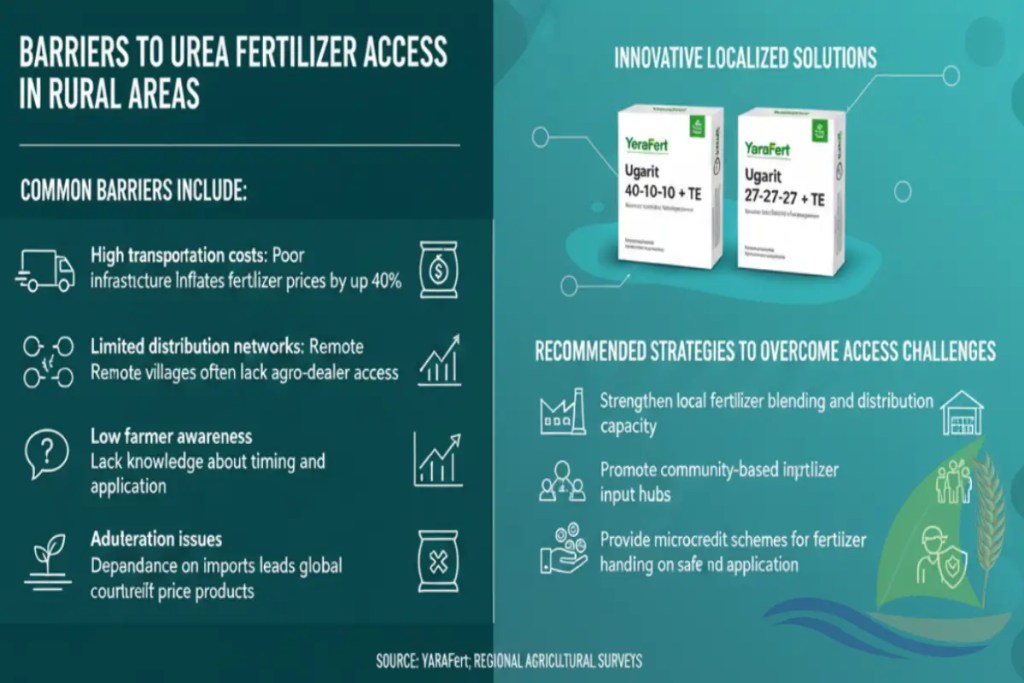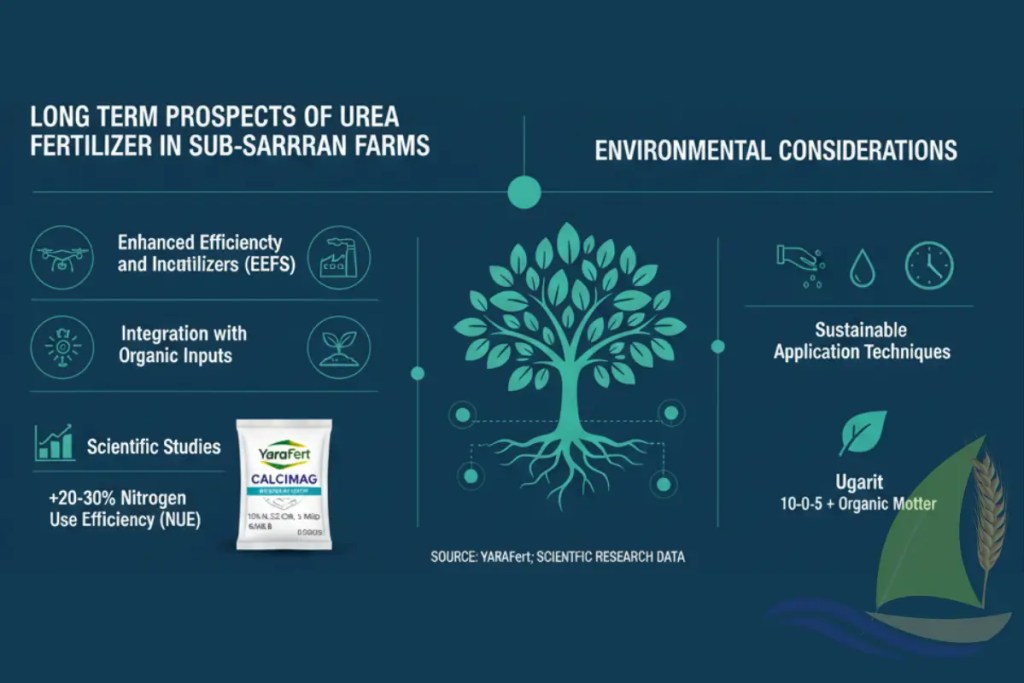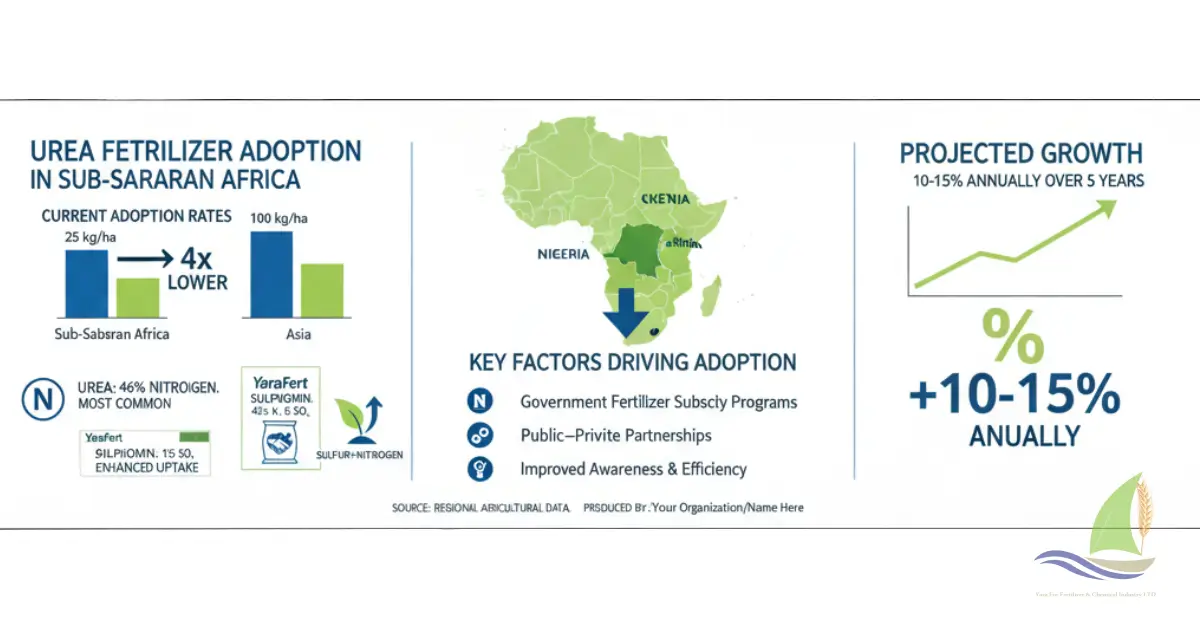Urea fertilizer remains one of the most vital agricultural inputs in Sub-Saharan Africa, providing a high concentration of nitrogen essential for crop growth. As the region continues to battle soil nutrient depletion, population pressure, and changing climate conditions, the role of urea fertilizer has become more pronounced. The right fertilizer practices — supported by innovations like YaraFert products such as SULPHOMIN, Biofast, and Ugarit formulations — are transforming agricultural productivity across the continent.
Current Urea Fertilizer Adoption Rates in the Region
The adoption of urea fertilizer in Sub-Saharan Africa has been steadily increasing over the past decade, though still below global averages. According to regional agricultural data, fertilizer use averages less than 25 kg per hectare compared to over 100 kg per hectare in Asia. Among these, urea fertilizer remains the most commonly applied nitrogen source due to its 46% nitrogen content, affordability, and versatility across various soil types.
Countries like Nigeria, Kenya, Ghana, and Ethiopia have spearheaded national fertilizer subsidy programs, encouraging greater use of urea fertilizer in maize, rice, and wheat production. However, adoption rates vary widely due to supply chain inefficiencies, cost barriers, and lack of farmer education.
Modern agronomic products such as SULPHOMIN, with its 45% nitrogen and 15% sulfur (SO?), are increasingly used as complementary solutions. The sulfur addition enhances nitrogen uptake efficiency — a critical advantage in Sub-Saharan soils that often lack secondary nutrients.
Key Factors Driving Adoption
- Government fertilizer subsidy programs
- Public–private partnerships improving input distribution
- Training on integrated soil fertility management (ISFM)
- Improved awareness of urea fertilizer’s nitrogen efficiency
With continued investment in these areas, urea fertilizer adoption is projected to grow by 10–15% annually over the next five years.
READ MORE: How Often Should You Apply Slow Release Fertilizer?
Crops Benefiting Most from Urea Fertilizer in Africa
Urea fertilizer supports a wide range of staple and cash crops grown across Sub-Saharan Africa. Nitrogen, the primary component of urea, promotes leafy growth, chlorophyll formation, and protein synthesis, making it indispensable for both food security and commercial production.
Major Crops That Benefit:
- Maize (Corn): The largest consumer of urea fertilizer, maize responds strongly to nitrogen applications at the vegetative stage. Farmers often use a split application strategy — half at planting and half during top dressing.
- Rice: Flooded paddy fields utilize urea fertilizer effectively, as it dissolves quickly and provides nitrogen to young tillers.
- Wheat and Barley: Urea promotes vigorous early growth, improving grain protein content and yield.
- Sugarcane: High nitrogen demand throughout the growing cycle makes urea fertilizer a staple input.
- Vegetables and Fruits: Tomato, cabbage, and onion fields benefit from balanced nitrogen from urea, complemented with potassium and phosphorus.
To further optimize performance, integrated nutrient products like Biofast (12% N, 12% P?O?, 12% K?O, plus 24% humic acid and 24% fulvic acid) improve soil structure and microbial activity. This not only enhances nitrogen efficiency from urea fertilizer but also supports sustainable soil fertility in the long term.
Barriers to Urea Fertilizer Access in Rural Areas

Despite its proven benefits, urea fertilizer access in rural Sub-Saharan Africa remains limited by several systemic challenges.
Common Barriers Include:
- High transportation costs: Poor infrastructure inflates fertilizer prices by up to 40%.
- Limited distribution networks: Remote villages often lack agro-dealer access.
- Low farmer awareness: Many smallholders lack knowledge about the correct timing and application rates of urea fertilizer.
- Price volatility: Dependence on imports exposes countries to global price shocks.
- Adulteration issues: Inadequate regulation has led to counterfeit or low-quality fertilizers.
These barriers reduce the overall efficiency of urea fertilizer programs and discourage consistent use among small-scale farmers. To address these gaps, innovative companies like YaraFert are expanding localized solutions. Products such as Ugarit 40-10-10 + TE and Ugarit 27-27-27 + TE offer balanced nutrition, simplifying fertilizer management while ensuring nitrogen is utilized effectively from urea-based applications.
Recommended Strategies to Overcome Access Challenges
To improve access and maximize benefits from urea fertilizer, stakeholders should:
- Strengthen local fertilizer blending and distribution capacity.
- Promote community-based input hubs.
- Provide microcredit schemes for fertilizer purchases.
- Train farmers on safe handling and application practices.
READ MORE: Seasonal Guide to Applying Slow Release Fertilizers
Urea Fertilizer Education Programs and Outreach
Education plays a pivotal role in maximizing the potential of urea fertilizer in Africa. Numerous agricultural extension programs now integrate practical demonstrations and farmer field schools focusing on fertilizer management.
Effective Outreach Components:
- Soil Testing and Analysis: Encourages precise urea fertilizer application based on soil nitrogen levels.
- Demonstration Plots: Showcase yield differences between urea-treated and untreated fields.
- Training on Application Timing: Helps farmers avoid nitrogen losses due to leaching or volatilization.
- Awareness on Complementary Nutrients: Promotes balanced fertilization using multi-nutrient products like SULFOMIX and Ugarit Cereal (15% N + 2% Cu) to enhance nitrogen response.
Moreover, educational campaigns emphasize the importance of integrating urea fertilizer with secondary nutrients such as sulfur and micronutrients. Products like Ugarit Multi (30% K?O, 32% S, 10% CaO) exemplify the new generation of fertilizers designed to complement urea and improve nutrient synergy.
Long-term Prospects of Urea Fertilizer in Sub-Saharan Farms

The future of urea fertilizer in Sub-Saharan agriculture is promising. With technological innovations, localized blending, and climate-smart practices, urea remains a cornerstone for enhancing food security and economic growth.
Emerging Trends and Innovations:
- Enhanced Efficiency Fertilizers (EEFs): Coated or stabilized urea formulations reduce nitrogen losses.
- Integration with Organic Inputs: Products like Ugarit 10-0-5 + 70% Organic Matter bridge mineral and organic nutrition, improving soil carbon and sustainability.
- Precision Agriculture: Drones and sensors are enabling more accurate urea fertilizer application rates.
- Regional Production: Investments in domestic fertilizer plants are expected to reduce import dependency and improve affordability.
Scientific studies have shown that integrating urea fertilizer with secondary and micronutrients can increase nitrogen use efficiency (NUE) by 20–30%. For instance, the use of YaraFert CALCIMAG (15% N, 22% CaO, 3% MgO, 0.5% B) not only enhances nitrogen uptake but also strengthens plant cell walls and improves resistance to abiotic stress.
Environmental Considerations
While urea fertilizer is highly effective, overuse can lead to nitrogen leaching and greenhouse gas emissions. Therefore, sustainable application techniques — such as band placement, urease inhibitors, and split dosing — are essential for responsible nutrient management.
Conclusion: Empowering African Farmers Through Smarter Fertilization
The journey toward sustainable agricultural transformation in Sub-Saharan Africa depends heavily on efficient use of urea fertilizer. When paired with balanced nutrition and proper education, it can unlock the full yield potential of African soils and crops.
Companies like YaraFert are leading this transformation with innovative, scientifically formulated products such as SULPHOMIN, Biofast, and the Ugarit range — all designed to enhance urea fertilizer performance, soil health, and crop productivity.
Are you ready to optimize your crop yields and improve soil fertility with cutting-edge fertilizer technology?
? Explore YaraFert’s full product range today or contact our agronomy experts for tailored guidance on maximizing your urea fertilizer applications. Empower your farm with smarter solutions and sustainable growth.
READ MORE: Top Slow Release Fertilizers for Houseplants: A Complete Guide

